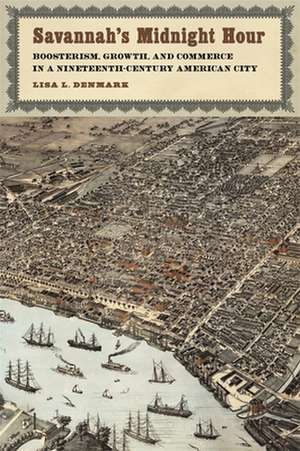Savannah's Midnight Hour
Autor Lisa L Denmarken Limba Engleză Hardback – 30 noi 2019
Beginning in the 1820s and continuing into the 1870s, Savannah's resourceful government leaders acted enthusiastically and aggressively to establish transportation links and to construct a modern infrastructure. Taking the long view of financial risk, the city/municipal government invested in an ever-widening array of projects--canals, railroads, harbor improvement, drainage-- because of their potential to stimulate the city's economy. Denmark examines how this ideology of over-optimistic risk-taking, rooted firmly in the antebellum period, persisted after the Civil War and eventually brought the city to the brink of bankruptcy. The struggle to strike the right balance between using public policy and public money to promote economic development while, at the same time, trying to maintain a sound fiscal footing is a question governments still struggle with today.
| Toate formatele și edițiile | Preț | Express |
|---|---|---|
| Paperback (1) | 262.13 lei 6-8 săpt. | |
| University of Georgia Press – 30 sep 2022 | 262.13 lei 6-8 săpt. | |
| Hardback (1) | 447.13 lei 6-8 săpt. | |
| University of Georgia Press – 30 noi 2019 | 447.13 lei 6-8 săpt. |
Preț: 447.13 lei
Nou
Puncte Express: 671
Preț estimativ în valută:
85.56€ • 89.57$ • 70.79£
85.56€ • 89.57$ • 70.79£
Carte tipărită la comandă
Livrare economică 05-19 aprilie
Preluare comenzi: 021 569.72.76
Specificații
ISBN-13: 9780820356327
ISBN-10: 0820356328
Pagini: 266
Dimensiuni: 157 x 235 x 20 mm
Greutate: 0.56 kg
Editura: University of Georgia Press
ISBN-10: 0820356328
Pagini: 266
Dimensiuni: 157 x 235 x 20 mm
Greutate: 0.56 kg
Editura: University of Georgia Press
Notă biografică
LISA L. DENMARK is a professor of history at Georgia Southern University.
Descriere
Argues that Savannah's development is best understood within the larger history of municipal finance, public policy, and judicial readjustment in an urbanizing nation. In providing such context, Lisa Denmark adds constructive complexity to the conventional Old South/New South dichotomous narrative.
